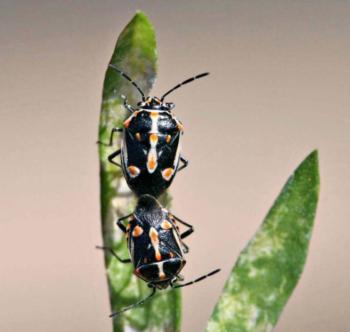Management of the Bagrada Bug in Nurseries
by Darcy A. Reed, Julie P. Newman, Thomas M. Perring, James A. Bethke, John N. Kabashima
Although the Bragada bug has caused devastating crop losses in California for growers of organic vegetable crops, this invasive pest is also a major problem in nurseries where bedding plants, plugs and transplants are produced in the mustard family (Brassicaceae). Moreover, because the Bagrada bug is a B-rated pest, it is subject to eradication, containment, control, or other holding action at the discretion of the individual county agricultural commissioner; when found in the nursery it is subject to state-endorsed holding action and eradication. Strict monitoring of outbound plants is required to prevent pest spread through the movement of plant material. Since the Bagrada bug can be found incidentally on a broad range of plant species, extensive crop monitoring in nurseries is necessary.
This plant-feeding stink bug, also called painted bug (Bagrada hilaris), infests wild mustard weeds in late winter to early spring. Pest populations rapidly increase in the weeds when seasonal temperatures rise and invade mustard family crops after the weeds dry out in late summer. The Bagrada bug is an invasive pest species, native to Africa, that was first found in Los Angeles County in 2008. By 2012, the pest had disseminated to San Diego, Imperial, Orange, Riverside, San Bernardino, Ventura, Santa Barbara and San Luis Obispo counties. According to information obtained from several UC Cooperative Extension advisors (Surendra Dara, farm Advisor/IPM advisor in San Luis Obispo and Ventura counties; David Haviland, farm advisor in Kern County; and Shimat Joseph, IPM advisor, Monterey County), the Bagrada bug seems to survive cold winters and continues to spread to various counties in California. It has since been reported in San Francisco, Fresno, Monterey and San Benito counties; was suspected to be present in Santa Cruz County in 2013; and appears to have been present in Kern County since 2010.
Identification and management of this pest was discussed in the UCNFA News Spring 2013 edition (Ventura/Santa Barbara and San Diego/Riverside regional reports). Since then, we have published provisional UC IPM Treatment Guidelines for the Bagrada bug in nurseries, which includes details on pest management practices (monitoring, cultural control, mechanical control and chemical control), as well as information on the identification and biology of this pest, plant damage symptoms, host range and references. The UC IPM Treatment Guidelines for the Bagrada bug are available at http://www.ipm.ucdavis.edu/PDF/PMG/bagradabug.pdf.

Adult Bagrada bugs are black with orange and white markings and are commonly found mating, positioned end-to-end. Multiple stages of adults and nymphs (not shown) have caused large white stippled areas on this alyssum plant. Photo by G. Arakelian, Los Angeles County Agriculture Commissioner’s Office.
Darcy A. Reed is Staff Research Associate, Department of Entomology, UC Riverside; Julie P. Newman, is Farm Advisor Emeritus, UC Cooperative Extension, Ventura and Santa Barbara Counties; Thomas M. Perring is Professor, Department of Entomology, UC Riverside; James A. Bethke is Farm Advisor, UC Cooperative Extension, San Diego and Riverside Counties; John N. Kabashima, is Farm Advisor, UC Cooperative Extension, Orange and Los Angeles Counties.












